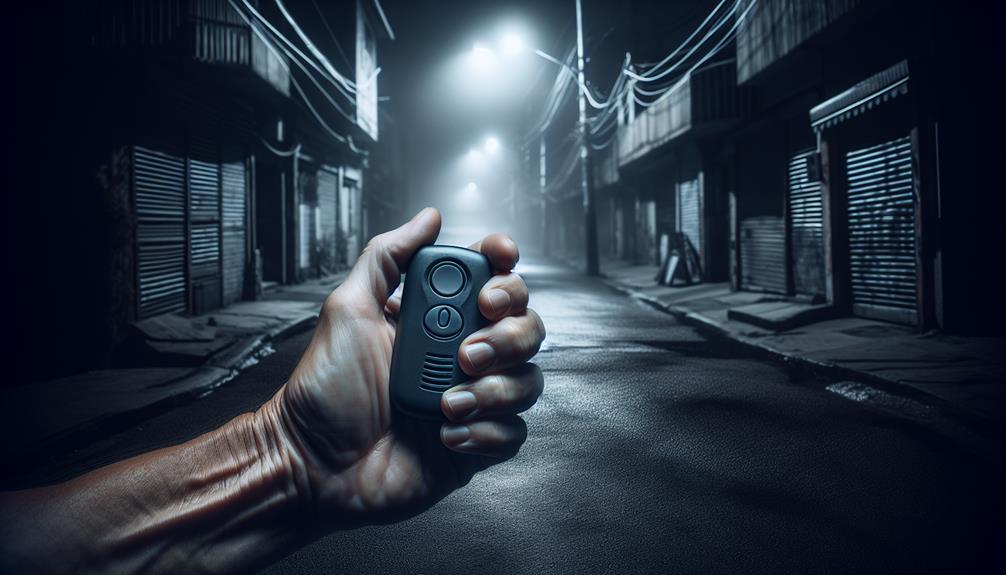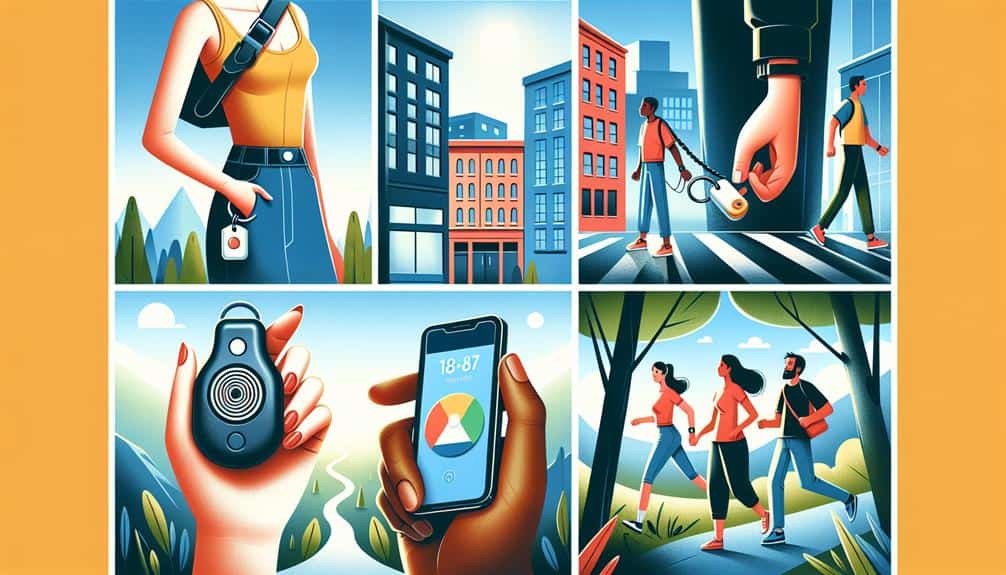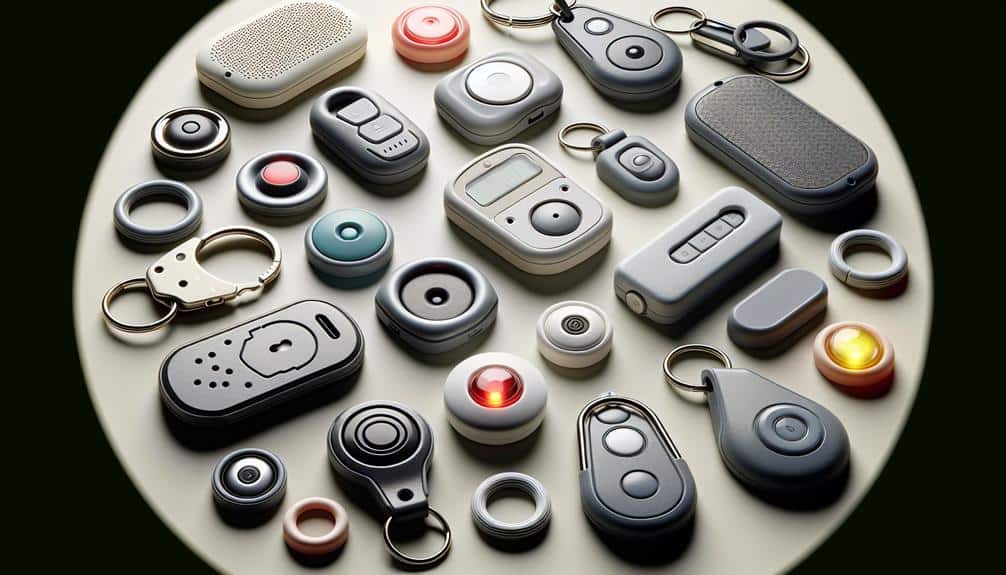Unveiling the Truth: Do Personal Safety Alarms Really Work?

Curious if personal safety alarms actually work? You’re not alone! These nifty devices, whether they’re keychain or wristband alarms, emit ear-piercing sounds up to 140 decibels when activated, startling potential attackers and buying you essential escape time. With features like GPS tracking and easy activation mechanisms, they’re designed to enhance your personal security in real-life scenarios. However, they do have limitations—think crowded places or battery failures. While alarms are a fantastic tool, combining them with self-defense skills or other safety measures can increase your protection. Want to know how to maximize your safety in different situations? Keep exploring!
Types of Personal Safety Alarms

When it comes to personal safety alarms, you have several types to choose from, each designed to suit different needs and preferences. Keychain alarms are popular personal safety devices because of their compact size and easy access in emergencies. You can attach them to your keys, bag, or belt loop, making them a convenient choice for anyone on the go.
Wristband alarms offer hands-free protection, allowing you to activate the alarm quickly without fumbling for a device. Imagine having the peace of mind that comes with knowing your safety is just a flick of the wrist away.
Necklace alarms provide a more discreet safety measure, blending seamlessly into your everyday attire while still being easily accessible when needed.
For the tech-savvy, app-based alarms leverage your smartphone’s capabilities, offering features like GPS tracking and automatic emergency notifications to your chosen contacts.
Wearable alarms, such as bracelets or clips, make sure you’re never without your personal safety devices, allowing you to carry your protection with you at all times. Whether you’re jogging in the park, heading to work, or just out and about, there’s a personal safety alarm tailored to your lifestyle and needs.
How Personal Safety Alarms Work
To understand how personal safety alarms work, you need to know that they typically activate by either pushing a button or pulling a pin, instantly releasing a blaring sound, akin to a siren at a rock concert, to grab everyone’s attention.
This ear-piercing noise isn’t just for show; it serves to scare off potential attackers and alert nearby people that you’re in trouble.
While some alarms stick to the basics, others come with fancy features like GPS tracking, making them the Swiss Army knives of personal safety.
Activation Mechanism Explained
By simply pressing a button or pulling a pin, you can activate a personal safety alarm that emits a loud siren to deter attackers and attract attention. The activation mechanism is designed for quick and easy use, guaranteeing you can call for help swiftly in an emergency. Imagine being in a risky situation where every second counts; with a personal safety alarm, you’ve got a lifeline at your fingertips.
Here’s how it works:
- Button Activation: Press a clearly marked button to trigger the alarm, perfect for high-pressure moments.
- Pin Pull: Pull a pin attached to the alarm, which is especially effective if you’re grappling with potential attackers.
- Portable Design: Compact and lightweight, these alarms fit easily into pockets or bags, making them super convenient to carry around.
These alarms aren’t just gadgets; they’re peace-of-mind providers. The loud siren sound is loud enough to make even the bravest attacker rethink their life choices, and it grabs the attention of anyone nearby. It’s like having a superhero sidekick that doesn’t need a cape.
Sound Emission Details
After activating your personal safety alarm, the real magic happens through its powerful sound emission capabilities. This tiny device packs a punch, emitting a loud sound ranging from 120 to 140 decibels—enough to startle anyone in the vicinity, including potential attackers. Imagine the sound of a jet engine or a rock concert, only more attention-grabbing and piercing! This high-decibel blast can be heard up to 1000 feet away, ensuring that help isn’t far behind.
The primary goal of this loud sound emission is to disorient attackers, giving you those precious moments to make a quick escape or seek assistance. It’s like throwing an auditory flashbang; the sudden, overwhelming noise can disrupt an attacker’s focus, allowing you to regain control of the situation.
Many personal safety alarms come with multiple sound options, such as sirens, alarms, or unique tones, providing versatility for different scenarios. Whether you’re on a crowded street or in a secluded park, there’s a setting designed to maximize your safety.
Key Features to Look For

When selecting a personal safety alarm, prioritize models with loud siren sounds to effectively deter potential attackers. A loud alarm can startle an assailant and attract attention, giving you precious seconds to escape.
Equally important is the ease of activation; you want quick access to the alarm in emergencies. Imagine fumbling with a complex mechanism when every second counts—that’s not optimal!
Portable alarms are a game-changer, allowing you to carry protection effortlessly in your pocket or purse. Lightweight and compact designs ensure you won’t feel burdened, making them perfect for jogging or late-night commutes.
Long-lasting batteries are another essential feature, because what’s the point of an alarm if it dies when you need it most? Look for models that guarantee extended battery life, so you’re always prepared.
Here’s a quick checklist:
- Loud siren sounds: Ensures maximum deterrence and attracts attention.
- Quick access: Easy activation mechanisms for immediate use.
- Portable design: Lightweight and compact for convenient carry.
Effectiveness in Real-Life Scenarios
When you think about personal safety alarms, real-life usage examples highlight their effectiveness, from thwarting potential attacks to ensuring quick responses from emergency services.
Imagine a scenario where someone’s walking home late and feels threatened—activating their alarm can scare off the attacker and alert nearby people or authorities in seconds.
Actual Usage Examples
Imagine envisioning walking home late at night and feeling a surge of confidence as you grip your personal safety alarm, knowing it’s deterred attackers and summoned help for countless others.
Envision this: an emergency strikes while you’re walking alone, but with a quick press of your personal attack alarm, you instantly have a lifeline. The effectiveness of personal safety alarms in real-life scenarios can’t be overstated.
Consider these real-world examples:
- Samantha’s Story: She was walking home from work late one evening when she noticed someone following her. Her personal safety alarm’s loud siren scared the person away and attracted nearby residents, ensuring her safety.
- Jake’s Experience: During an early morning jog, Jake encountered a suspicious stranger. Activating his alarm, he not only scared off the potential threat but also alerted a passing cyclist who stayed with him until the police arrived.
- Lily’s Situation: Stuck in a desolate parking lot with a malfunctioning car, Lily used her alarm to draw attention, leading a security guard to her location within minutes.
These anecdotes highlight how personal safety alarms provide non-violent defense, reduce the fear of walking alone, and guarantee quicker emergency responses.
Crime Deterrence Impact
Personal safety alarms have proven effective at deterring crime and reducing assault incidents, giving users peace of mind in vulnerable situations. These handy devices can make a world of difference when it counts the most.
Imagine you’re walking home alone at night, and suddenly, someone suspicious approaches you. The loud siren sound of a personal safety alarm can startle and deter assailants, often causing them to flee the scene. It’s like your own mini superhero, minus the cape!
Studies have shown that these alarms don’t just make noise; they also empower individuals by providing a non-violent defense option. Instead of resorting to physical confrontation, you can alert nearby people and authorities to your predicament. This sense of control can greatly boost your confidence and reduce the fear of walking alone.
Moreover, many personal safety alarms are equipped with features that send discreet alerts to Monitoring Centers, enabling a swift police response. This proactive approach not only helps during an attack but also ensures you’re never truly alone.
In real-life scenarios, these alarms have saved lives and prevented countless potential incidents, demonstrating their value in enhancing personal safety.
Limitations of Personal Alarms

Despite their benefits, personal safety alarms have significant limitations that you should consider. One major issue is their effectiveness in crowded areas. Imagine you’re at a packed concert or a bustling subway station; the loud noise from your personal alarm might just blend into the background, failing to attract the attention you desperately need.
Another limitation is battery life. Personal alarms rely on batteries to function, and these batteries can run out at the most critical moments. If you don’t regularly check and replace them, you could be left with a useless piece of plastic when you need it most.
Here are a few other drawbacks:
- Multiple attackers: Personal alarms mightn’t deter more than one assailant.
- Intoxicated individuals: People under the influence may ignore or react irrationally to alarms.
- Silent scenarios: In situations where silence is vital, an alarm could do more harm than good.
These limitations highlight the importance of not relying solely on personal alarms for your safety. They should be part of a broader strategy that includes being aware of your surroundings, having a safety plan, and perhaps even learning self-defense techniques. Remember, no single tool can provide complete protection.
Comparing Traditional Vs. Monitored Alarms
When comparing traditional and monitored personal safety alarms, it’s important to understand the distinct ways they provide assistance during emergencies.
Traditional personal alarms are straightforward—they emit a loud sound to attract bystanders’ attention, hoping someone nearby will come to your aid. Think of it as yelling for help but with a mechanical scream. The catch? If no one’s around or willing to help, you’re out of luck.
On the flip side, monitored alarms are like having a personal bodyguard on call. They don’t just rely on noise; they discreetly alert a Monitoring Centre. Imagine pressing a button and knowing that professionals are immediately notified and can call the police for you. This can be critical, especially if you’re in a secluded area or facing an unresponsive crowd.
While traditional alarms are excellent for quick, loud alerts, they can be hit or miss depending on the situation.
Monitored alarms, however, offer continuous support and the peace of mind that someone is always watching your back, even beyond immediate emergencies.
Factors Affecting Alarm Performance

In evaluating the effectiveness of personal safety alarms, several critical factors come into play that can greatly influence their performance. One of the main considerations is how loud the alarm is. A deafening sound can grab attention and potentially deter attackers, but in crowded areas, the alarm might get drowned out by ambient noise.
You also need to think about battery life. A dead battery at a pivotal moment? That’s like having a lifeguard who’s afraid of water. Regular maintenance guarantees your alarm is ready when you need it most.
Here are a few key elements to ponder:
- Crowded environments: High noise levels can mask your alarm’s sound, reducing its effectiveness.
- Battery life: Limited battery life can mean the difference between safety and danger.
- Situational suitability: In scenarios where silence is golden, sound alarms might be impractical.
Lastly, think about enhancing personal safety by combining alarms with other measures. Self-defense classes, smartphone apps, and even a trusty whistle can create a thorough safety net. Remember, while personal safety alarms can be a crucial tool, their performance hinges on these factors, so make sure you’re prepared on all fronts.
Alternatives to Personal Safety Alarms
Looking beyond personal safety alarms, you’ll find a range of tools and strategies that can enhance your safety toolkit, each with its unique strengths. Self-defense training can empower you to handle risky situations with confidence, while mobile safety apps offer features like real-time location tracking and emergency contacts at your fingertips.
Traditional whistles, though seemingly old-school, can be lifesavers in situations where a loud, piercing sound is needed to draw immediate attention.
Self-Defense Tools Overview
Beyond personal safety alarms, there are several self-defense tools like pepper spray, tasers, and whistles that offer effective alternatives for protection. Each of these tools has its unique features and benefits, catering to your individual preferences and situations.
Pepper spray is a popular choice, known for its ability to temporarily disable attackers by causing intense eye irritation, coughing, and difficulty breathing. With a range of up to 10 feet, it provides you with a safe distance to escape. Imagine spritzing a would-be assailant and watching them scramble—it’s like your own personal superhero moment, minus the cape!
Tasers, on the other hand, deliver a non-lethal electric shock that can incapacitate an attacker. They’re a fantastic option if you prefer to keep a safe distance while ensuring the assailant is temporarily immobilized. Think of it as your high-voltage peacekeeper.
Whistles are the unsung heroes of self-defense tools. Low-cost and easy to use, they can attract attention and deter attackers in emergency situations. It’s like having your own personal alarm system right in your pocket.
- Key alternatives to personal safety alarms:
- Pepper spray: Effective range up to 10 feet
- Tasers: Non-lethal electric shock
- Whistles: Low-cost attention grabbers
Mobile Safety Apps
Mobile safety apps offer a tech-savvy way to stay safe and connected in potentially dangerous situations. Imagine being able to activate personal security features right from your smartphone! These apps provide essential services like GPS location tracking, emergency contacts, and even automatic 911 calls. You can discreetly signal for help without drawing attention, unlike traditional alarms that rely on a loud sound.
With live location sharing, your loved ones can track your movements in real-time, ensuring you’re never truly alone. Whether you’re moving through unfamiliar areas or making your way home late at night, these apps can be a lifesaver. Here’s a quick comparison to highlight their features:
| Feature | Benefit |
|---|---|
| GPS Location | Enables real-time tracking |
| Emergency Services | Directly contacts 911 |
| Discreet Activation | Silent alerts for covert help |
| Loud Sound Option | Alerts nearby individuals |
The convenience of having personal security at your fingertips can’t be overstated. For instance, apps like ‘bSafe’ and ‘Noonlight’ are popular choices that combine these features. These tools are designed to enhance your peace of mind, making modern technology your ally in personal safety. So, why not embrace these digital guardians and stay one step ahead in ensuring your safety?
Traditional Whistles Benefits
Traditional whistles offer a reliable, low-cost alternative to personal safety alarms that don’t rely on batteries or technology.
Imagine being in a situation where you need to draw attention fast—traditional whistles can reach up to 120 decibels, making sure everyone within earshot knows you need help.
These devices are lightweight, portable, and incredibly easy to use, making them perfect for immediate alerting in emergencies.
Consider the following benefits of using traditional whistles:
- Always Ready: Unlike electronic devices, whistles don’t require batteries, ensuring they function reliably at all times.
- Loud and Clear: With the ability to produce a piercing sound, they can effectively deter an attacker by drawing attention to your location.
- Proven Track Record: Whistles have been used for decades in various settings, from sports fields to urban streets, proving their effectiveness in deterring unwanted attention.
Sure, personal safety alarms are packed with tech, but what happens when the battery dies?
Traditional whistles keep things simple—they’re always ready, no charging required.
Imagine you’re on a late-night jog, and you sense danger. A quick blow of your whistle can make all the difference, alerting others and potentially scaring off any would-be attackers.
Choosing the Right Alarm for You

Choosing the right personal safety alarm involves evaluating your lifestyle, typical locations, and potential risks. Think about your daily activities—whether you’re a night jogger, a student walking to classes, or someone who travels often. Each scenario might require a different type of alarm to make sure you’re feeling safe and secure.
When selecting a personal safety alarm, consider the specific features you need. Do you want something that emits a loud noise, or do you prefer an alarm with GPS tracking? Some alarms even come with LED lights or can send alerts to your contacts. It’s essential to choose one that fits seamlessly into your routine without being a hassle to use.
Here’s a quick comparison to help you decide:
| Lifestyle | Typical Locations | Suggested Alarm Features |
|---|---|---|
| Night Jogger | Parks, Streets | Loud noise, LED light |
| Student | Campus, Public Transport | Discreet, GPS tracking |
| Frequent Traveler | Airports, Hotels | Compact, SOS messaging |
| Elderly | Home, Neighborhood | Easy to use, fall detection |
| Hiker | Trails, Mountains | Waterproof, long battery life |
Selecting an alarm that aligns with your personal preferences and comfort level will provide the right balance of functionality, convenience, and reliability for your peace of mind.
Enhancing Personal Security
Enhancing your personal security with a safety alarm can greatly reduce the risk of assault and increase your overall sense of safety. Imagine you’re a lone worker or someone walking home late at night. A personal safety alarm could be your best companion, ready to draw attention and call for help when you need it most.
These alarms aren’t just about making noise; they’re about giving you a non-violent way to protect yourself. They act as a deterrent to potential attackers, markedly lowering the risk of sexual assault. In fact, statistics show that the presence of a safety alarm can make an assailant think twice before approaching.
Here’s why you should consider one:
- Immediate Alerts: They provide instant notifications to authorities, ensuring quick response times.
- Empowerment: Carrying an alarm boosts your confidence, reducing the anxiety of being alone in vulnerable situations.
- Versatility: Suitable for various demographics, from students to seniors to lone workers.
Moreover, if you opt for a monitored personal alarm, it discreetly alerts monitoring centers, enabling proactive police intervention before things escalate.
Frequently Asked Questions
Do Personal Safety Alarms Actually Work?
Yes, they work! With loud alarm volume, reliable battery life, and easy activation mechanisms, personal safety alarms are effective. Their portability factor guarantees you can carry them anywhere, enhancing your personal safety and deterring potential attackers.
Is It Worth Having a Personal Alarm?
You might wonder if it’s worth having a personal alarm. Considering the cost comparison, reliable battery life, positive user testimonials, and the effectiveness of the panic button, it’s a small investment for invaluable peace of mind.
What Is the Best Personal Protection Device?
When choosing the best personal protection device, consider pepper spray, a stun gun, a tactical flashlight, or a self-defense keychain. They’re effective, easy to use, and offer immediate defense options in threatening situations.
Will a Personal Alarm Scare a Dog Away?
Yes, a personal alarm can scare a dog away. Loud noises disrupt dog behavior and their animal instincts trigger an emergency response, making them flee. Personal alarms effectively leverage this instinct to enhance your safety.


2 Responses